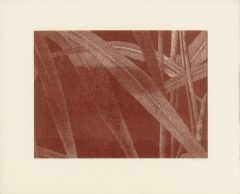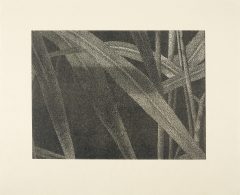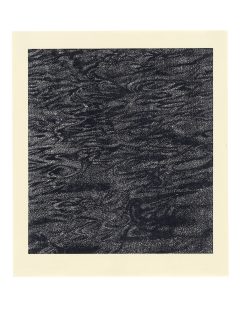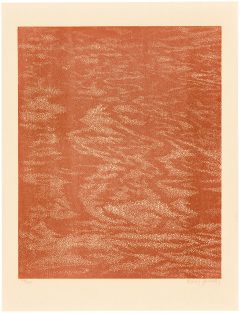Franz Gertsch
Gräser I (Detail 3)
2002

woodcut on Kumohadamashi Japan paper
Image: 47 × 64 cm | 18 1/2 × 25 1/4 in
Sheet: 72 × 89 cm | 28 1/3 × 35 in
Signed and "ea" marked also verso "3-1 ea" marked
Edition of 5 + e.a.. Publisher: Museum Franz Gertsch, Burgdorf
One of 6 details of the bigger woodcut »Gräser I«, 1999-2000, each published in 6 different colours
Interim Catalogue Raisonné by Mason 2013 no. 22. detail 3
Price includes German VAT. Shipping costs are not included. All prices are subject to change and availability. Change region and currency
Museum Franz Gertsch, Burgdorf; Private Collection Switzerland
- Galerie Ludorff, "The Simple Things. Minimalism and more...", Düsseldorf 2024
- Museum Sinclair-Haus/Altana Kulturstiftung, "Franz Gertsch Holzschnitte. Aus der Natur gerissen", Bad Homburg 2013
- Galerie Kornfeld, "Franz Gertsch. Holzschnitte - ausgewählte Separatdrucke", Bern 2011
- Andrea Firmenich/Johannes Janssen (ed.), "Franz Gertsch Holzschnitte. Aus der Natur gerissen", exhib.-cat. Museum Sinclair-Haus/Altana Kulturstiftung, Cologne 2013, p. 123
While Jasper Johns still asked "Is it a flag or a painting?", Franz Gertsch's paintings must read "Is it a painting or a photography? The Swiss artist, known for his highly precise and magnificent works, completely dissolves the border between painting and photography. In the wake of American Pop Art and the new Photorealism of the 1970s, Gertsch counts artists like Chuck Close and Europeans like Gerhard Richter among the most important representatives of this artistic period.
In the 1970s, Gertsch devoted himself primarily to hippie culture, the big city, and its subcultures. Especially the urban bohemians and their stars like Patti Smith, Gertsch set impressive painted monuments. These are quite unimportant scenes, such as the mutual application of make-up and changing clothes for a party, which Gertsch enlarges into the monumental. There is a great discrepancy between the amusement of the scenes depicted and the immense amount of time he takes to complete his hyper-realistic paintings.
In 1986, however, Franz Gertsch's work broke with painting. For the next ten years, the artist will not produce a single painting. Instead of brush and canvas, he will turn exclusively to the classical medium of woodcuts. The medium of the woodcut, which was used for his block-like chiaroscuro contraste, refines and advances Gertsch in a variety of ways. By processing the printing plate with small hollow irons, with which he covers the surface with tiny holes, the prints achieve a rich nuance of grey and intermediate tones, which are generally not possible in this medium. This specially developed pointilistic technique allows the artist to develop a plasticity that is atypical of the process and which appears anything but "woodcut-like". The dotting of the wooden panel evokes a slight vibration of the monochrome colour surface, so that his motifs are gripped by gentle movement.
Franz Gertsch is visibly devoting himself almost exclusively to the examination of nature and the possibilities of woodcuts, which he seems to explore in terms of format on monumental printing plates measuring up to 2 x 3 metres. Thematically, he now deals almost exclusively with stone formations, river courses and, in particular, grasses, which he captures on his plates and prints in very small editions, of which each individual sheet of an edition is often chosen in a different shade, so that his prints can often be attributed a unique character. Of the particularly large motifs, Gertsch occasionally publishes a section of the overall view as a smaller edition. Our graphic "Gräser I (Detail 3)" also shows a detail from the motif of the same name "Gräser I" (1999-2000, 136.5 x 124.5 cm). The sheet "Water" (p. 113), on the other hand, is an independent motif. Thus Gertsch remains true to the mode of lifelike representation in his graphic work, but alienates the found nature through the reduction of colourfulness. His "Landscapes in the Landscape "1) are an expression of timelessness and, contrary to the constant urge for speed, claim a moment of calm for themselves.
1) Zit. Franz Gertsch, in: Andrea Firmenich/Johannes Jannsen (Ed.), "Franz Gertsch. Woodcuts. Torn from Nature", Cologne 2013, p. 93.





